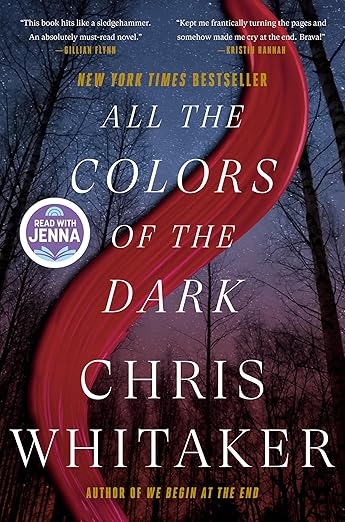Table of Contents

First Published:December 5, 2023
Genre: Historical Fiction, Thriller, Mystery
Time Period: 1975 to 2001
Setting / Location: Primarily Monta Clare, Missouri, but travels across various US states.
Pages: 261 chapters, divided into distinct time-period sections
Summary of All the Colors of the Dark
The story begins in the small town of Monta Clare, Missouri, in 1975. Thirteen-year-old Joseph “Patch” Macauley, known for the eye patch covering his missing eye, fashions himself a pirate, a fiction encouraged by his mother, Ivy, to cope with reality. One morning, Patch witnesses Misty Meyer, a girl from school, being attacked by a hooded man near an old railroad clearing. Driven by instinct, he intervenes, tackling the attacker and urging Misty to run. During the struggle, the man stabs Patch in the stomach before fleeing. Patch is left bleeding and is subsequently abducted, vanishing from Monta Clare.
Simultaneously, thirteen-year-old Saint Brown, Patch’s closest friend and a budding beekeeper, discovers her beloved bees have inexplicably disappeared from their hive. Her search for the bees is quickly overshadowed by the news of Patch’s heroic act and disappearance. Finding Patch’s bloodied T-shirt and distinctive eye patch in the clearing where he saved Misty confirms the town’s worst fears. Chief Nix begins an investigation, hampered by Misty’s shock and the attacker’s masked face. Saint, however, becomes singularly focused, her life now dedicated to finding her lost friend. Early suspicion falls on the local doctor, Martin Tooms, after Saint learns he was seen near the woods that morning, though his explanation of searching for a lost dog raises her doubts, particularly when she asserts he doesn’t own one.
The book then follows Patch’s harrowing experience in captivity (The Lovers, the Dreamers: 1975). He finds himself in total darkness, held in a basement bunker with another captive, a girl named Grace. She becomes his guide and confidante in their shared prison. They exchange stories, exercise relentlessly, and rely on scripture for strength, particularly when their captor, Eli Aaron, is near. Grace reveals fragments of her past and knowledge that seems beyond her years. Patch, protective and falling for her, attempts to attack Aaron with a loosened brick during one of Grace’s birthdays, resulting in a severe beating for himself and a deepened trauma.
Patch is eventually found near death by Saint (The Painter: 1976), though Grace is gone. He spends time recovering in the hospital, with Saint a constant presence. The investigation uncovers Eli Aaron’s identity and links him to other missing girls, some found buried on his remote property, often with rosary beads. Dr. Tooms is implicated but maintains his innocence regarding Patch, claiming he only treated the boy’s initial stab wound at Aaron’s behest. Patch, now profoundly changed, finds an unlikely mentor in Sammy, the town’s cynical art gallery owner, who recognizes the boy’s trauma and gives him supplies and a space to paint. Patch throws himself into art, obsessively painting Grace from memory, trying to capture the girl he knew only in darkness, his art becoming both therapy and a continuation of his search. Saint, meanwhile, pursues her own investigation, convinced of Tooms’s deeper involvement.
Years pass (The Broken Hearts: 1978). Patch works grueling shifts in the mines, dates Misty Meyer, their relationship strained by his unwavering focus on finding Grace. He travels the state, following leads on missing girls, collecting photos and stories. Misty, though loving him, struggles with the ghost of Grace and the darkness Patch carries. Saint, now a police officer (Cops and Robbers: 1982), officially investigates the cold cases, her path converging again with Patch’s. She uncovers evidence linking Tooms more concretely to Eli Aaron and the murder of Callie Montrose, another missing girl whose blood is found in Tooms’s farmhouse basement. Patch, frustrated by the lack of progress and Tooms’s silence (now imprisoned), begins robbing banks across several states using a distinctive one-shot flintlock pistol, donating the money to charities for missing persons.
This sets Saint on his trail (The Hunt: 1983). What follows is a tense chase across the country. Saint, torn between her duty and her deep bond with Patch, uses her knowledge of his methods and Grace’s fragmented stories from his interview tapes to predict his movements. Patch becomes increasingly reckless, his robberies escalating. The hunt culminates in a confrontation in Alabama, where Saint, finding Patch at the end of his rope but unwilling to surrender, is forced to shoot him.
Patch survives and serves time in prison (Fate: 1990). Upon his release after six years (likely due to Saint’s intervention and testimony), Saint is there to meet him. Their reunion is quiet, marked by the weight of years and unspoken truths. Patch learns he has a daughter, Charlotte, from his time with Misty, who tragically died of cancer while he was incarcerated. He attempts to build a life, taking custody of Charlotte (The Break: 1995). He renovates the old Macauley house, a project fueled by memory and a desire for roots, but his relationship with the sharp, perceptive Charlotte is complex, shadowed by his past and his continued, albeit quieter, search.
Patch visits Marty Tooms on death row (The Prisoner: 1998), seeking answers about Grace before the execution. Tooms, broken, eventually confesses he lied about Grace’s death, revealing she was alive when Patch was rescued but providing no location, only that she was Eli Aaron’s daughter and complicit in some ways, yet also a victim. He admits he killed Callie Montrose accidentally during a procedure. This revelation sends Patch spiraling.
The final section (Myths and Legends: 2001) sees Saint, now police chief, uncovering the last pieces. Eli Aaron, it turns out, had faked his death or escaped capture. Following clues related to rosary beads purchased recently and Aaron’s known religious fanaticism, Saint tracks him to Grace Falls, Alabama—the town Patch had painted from Grace’s descriptions. In a final confrontation at Grace’s family home (The Bleached House), Saint kills Eli Aaron, finding evidence that he ultimately killed his own daughter, Grace. Patch, arriving separately after deciphering clues left by Tooms and hearing Grace’s voice in his memory, finds the house, finds Grace’s grave, and achieves a painful closure. The story ends with Patch, Saint, and Charlotte on a sailboat, a fragile peace established, looking towards an uncertain future, forever bound by the dark colors of their shared past. How does one truly move forward when the past holds such a grip? Can hope finally win out against the longest odds?
List of Characters in All the Colors of the Dark
This list contains the main characters, including the key supporting characters as mentioned in All the Colors of the Dark. While it contains a long list of characters, it is not exhaustive. To get the full list of all the characters in the book, you can purchase All the Colors of the Dark Book Club Guide.
Main Characters:
Joseph “Patch” Macauley: A one-eyed, thirteen-year-old boy living in Monta Clare, Missouri. One of the two main protagonists in the novel. His life becomes a quest marked by trauma, art, and a search for a girl from his captivity.
Saint Brown: Patch’s childhood best friend. The other main protagonist in the book. A fiercely intelligent and determined individual who becomes a law enforcement officer, her life deeply intertwined with Patch’s and the mysteries surrounding him. She is also a beekeeper.
Grace: A mysterious girl Patch meets during his captivity. She is knowledgeable, a storyteller, and becomes a central figure in Patch’s life and search.
Chief Nix (later just Nix): The police chief of Monta Clare who investigates Patch’s disappearance and other local crimes.
Dr. Martin Tooms: A local doctor in Monta Clare.
Eli Aaron (Robert Peter Frederick): A figure shrouded in religious fanaticism.
Key Supporting Characters:
Ivy Macauley: Patch’s mother.
Norma Brown: Saint’s grandmother, a pragmatic and strong woman who raises Saint. She is a bus driver.
Misty Meyer: A classmate of Patch and Saint who Patch saves from an attack.
Sammy: The cynical, alcoholic owner of the Monta Clare Fine Art gallery who becomes an unlikely mentor and benefactor to Patch.
Charlotte Meyer Macauley: Patch and Misty’s daughter, a sharp, perceptive, and resilient girl who grows up in the shadow of her parents’ past.
Jimmy Walters: A classmate of Saint and Patch, later Saint’s husband. A kind but perhaps naive veterinarian.
Franklin Meyer: Misty’s wealthy and influential father.
Mary Meyer: Misty’s mother, concerned with social standing and the arts.
Warden Riley: The warden of the prison where Patch serves time and later where Tooms is on death row.
Blackjack: A formidable prison guard who interacts with Patch.
Cooper (Cooper Strike): A librarian at the prison where Patch is incarcerated, who forms a connection with him.
Himes: An FBI agent who works with Saint on Patch’s case and later recruits her.
Tug: An old inmate Patch befriends in prison, known for his stories and unique perspective.
Book Club Questions For All the Colors of the Dark
The questions have been curated to spark meaningful discussions in your book club meeting.
The title of the book All the Colors of the Dark is evocative. How do you interpret its meaning in relation to the events and the emotional landscape of the story? What “colors” did you see in the “dark” of the characters’ experiences?
Sammy, the art gallery owner, becomes an unlikely mentor to Patch. How did their relationship influence Patch’s development, and what did Sammy gain or perhaps lose from his involvement with Patch and his search?
Saint dedicates a significant portion of her life to finding Patch and then to understanding Grace. Do you view her dedication as an act of profound friendship, a coping mechanism for her own losses, or something else entirely? Why?
Dr. Martin Tooms is a deeply complex character. How did your perception of him evolve throughout the story, particularly with the final revelations about his relationship with Chief Nix and Callie Montrose? Was he ultimately a victim, a villain, or both?
Patch’s art is central to his coping and his search for Grace. What do his paintings, particularly “Grace Number One” and “Grace’s Main Street,” symbolize about his internal world and his memory of Grace?
The concept of “home” is multifaceted in the story – Patch’s childhood rental, the dark bunker, the Mad House, Grace’s Bleached House. What does “home” mean to different characters, and does anyone truly find it?
Chief Nix carries enormous secrets and burdens. What were the primary motivations behind his choices, especially regarding Dr. Tooms and the cover-up? Do you find his actions justifiable, understandable, or unforgivable?
Eli Aaron is presented as the primary antagonist, but his background as “Robert Peter Frederick,” an altar boy raised in a children’s home, adds another layer. How does this information affect your understanding of his motivations and his horrific actions?
Hope is a recurring, yet often painful, element in the story. Patch says, “Hope is expectation. Anyone that tells you less is lying to themselves.” Do you agree with this assessment, especially in the context of the characters’ prolonged searches?
Several characters, including Norma and Sammy, offer contrasting views on love, duty, and forgiveness. Which character’s philosophy or worldview resonated most with you, and why?
If you loved these questions and want more, we have created a comprehensive Book Club Guide Kit for All the Colors of the Dark by Chris Whitaker. This guide provides everything you need to host a lively and engaging book club meeting, including:
- Over 30 thought-provoking discussion questions in printable PDF format that will help you explore the novel’s themes of war, loss, healing, resilience, and the role of women in Vietnam war.
- Fun icebreaker questions to get your discussion started.
- Challenging word search puzzles based on the novel’s characters and events.
- Delicious food and drink ideas inspired by the novel.
- Insightful book quotes with explanations to help you understand the novel’s deeper meaning.
- Meeting record templates to take notes and keep track of your discussions, and so much more!
This guide is perfect for book clubs of all sizes and experience levels. It is a great resource for individual readers who want to deepen their understanding of the novel
Frequently Asked Questions - All the Colors of the Dark
What happened to Patch's eye in All the Colors of the Dark?
Patch was born with only one eye. His eye patch is a way he and his mother deal with this from a young age, embracing the “pirate” persona. It wasn’t an injury he sustained during the course of the story.
Why did Patch go to jail in All the Colors of the Dark?
Patch went to jail later in his life, years after his own abduction and after he had begun his search for Grace.
He was imprisoned for the death of Jimmy Walters, Saint’s ex-husband. The confrontation stemmed from Jimmy’s past abuse of Saint and the destructive rumors Jimmy spread about her. During an altercation, Patch threw a single punch at Jimmy, who then struck his head as he fell back. This led to Patch’s conviction and imprisonment.
How does Patch escape jail in All the Colors of the Dark?
Patch’s escape from prison was a cleverly orchestrated event with multiple contributing factors. A significant fight broke out in the prison, instigated by an inmate named Tug, causing chaos and distracting the guards. A construction worker outside the prison (whom Saint suspects Sammy arranged) cut a main power cable, leading to reliance on backup generators and disrupting normal security.
The librarian, Cooper (later revealed to be Cooper Strike, the son of Walter Strike, whose missing daughter Eloise resembled Grace), who Patch had befriended, used his position and keys to facilitate Patch’s escape. Cooper himself vanished during the incident, having seemingly left his post early with the help of a guard. The guard Blackjack allowed Cooper to leave his post before his shift officially ended, a breach that aided the escape.
Patch vanished amidst this chaos, not leaving through the main doors, implying he used an alternative route facilitated by Cooper and the general disruption.
Is All the Colors of the Dark based on a true story?
No, All the Colors of the Dark is a work of fiction. While it deals with very real and dark subjects like abduction and trauma, the specific characters and plot are created by Chris Whitaker.
Does Grace exist in All the Colors of the Dark?
Yes, Grace is a real character within the narrative of the book. She is Patch’s fellow captive in Eli Aaron’s basement bunker for a significant period. Their interactions, her stories, and her impact on Patch are detailed. The major revelation later in the story is that Grace is Eli Aaron’s daughter. This explains many aspects of her behavior and knowledge during their captivity. While for much of the book after his rescue, Patch and other characters like Chief Nix) questions whether Grace was a figment of his traumatized imagination or a coping mechanism, the later parts of the story, especially Tooms’s confessions and Saint’s investigation, confirm her physical existence and her tragic connection to Aaron.
The final chapters describe Patch finding Grace in Grace Falls, Alabama, in a climactic and emotional reunion in the barn. She is physically present and they interact.
Chris Whitaker Biography
Chris Whitaker is a British author who has quickly garnered international acclaim for his emotionally charged and character-rich stories that often reside in the spaces between crime fiction, mystery, and literary prose.
Before dedicating himself to writing full-time, Whitaker worked a variety of jobs, experiences that perhaps lend a certain grounded authenticity to the often intense circumstances his characters navigate. He has spoken openly about aspects of a challenging upbringing and a significant personal trauma in his youth – being the victim of a stabbing.
His narratives are frequently set in small, atmospheric American towns, locations that become almost characters in themselves, shaping the destinies and outlooks of the individuals within them. He is particularly noted for his exceptional skill in character development, creating protagonists and supporting figures who are flawed, often pushed to their limits, yet remain deeply human and relatable.
Chris Whitaker’s published books, in order of their initial major release, are:
Tall Oaks (2016): His debut introduced readers to his ability to weave together multiple storylines in a small-town setting following a child’s disappearance, blending dark humor with genuine pathos.
All The Wicked Girls (2017): This story further cemented his reputation for atmospheric settings and complex young characters, focusing on a mystery in a deeply religious town where girls are going missing.
We Begin at the End (2020): A breakout international bestseller, this novel garnered widespread critical acclaim, including the CWA Gold Dagger for Best Crime Novel. It tells the powerful story of a young girl, Duchess Day Radley, fiercely protecting her younger brother in the face of her mother’s self-destruction and the return of a man from their town’s troubled past.
All the Colors of the Dark (2024): His latest work, an ambitious and sprawling story that follows the decades-long aftermath of a childhood abduction, exploring the impact of trauma on two central characters, Patch and Saint, and their quests for answers and peace.
Was this post helpful?
We’d love to hear from you : )



